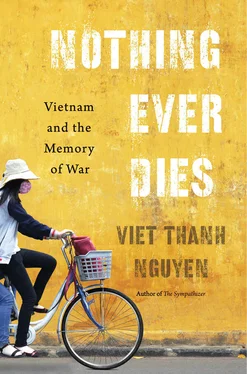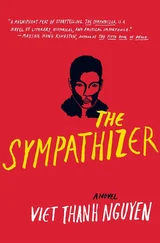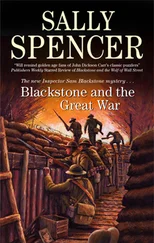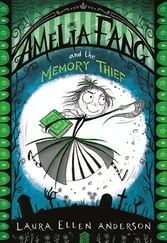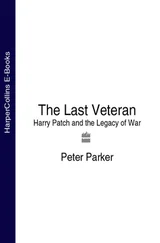Vietnam war films are all pro-war, no matter what the supposed message, what Kubrick or Coppola or Stone intended.… Fight, rape, war, pillage, burn. Filmic images of death and carnage are pornography for the military man; with film you are stroking his cock, tickling his balls with the pink feather of history, getting him ready for his real First Fuck. It doesn’t matter how many Mr. and Mrs. Johnsons are antiwar — the actual killers who know to use the weapons are not.… The supposedly anti-war films have failed. Now is my time to step into the newest combat zone. And as a young man raised on the films of the Vietnam War, I want ammunition and alcohol and dope. I want to screw some whores and kill some Iraqi motherfuckers. 28
Politicians, generals, journalists, think tank wise men (and women) do not deploy this language, but writers, artists, and filmmakers do. They recognize what cannot be said in polite company: war is pure sex, in addition to being politics by other means. On screen, Raimi shows an auditorium full of lustful young male Marines watching the helicopter assault from Apocalypse Now . Raimi’s camera cuts between the screen (which itself shows Apocalypse Now cross-cutting between helicopters and villagers) and the faces of Marines howling, cheering, and reaching cinematic orgasm while the air pirates blast the village. Then the lights suddenly come on, Apocalypse Now is suspended, and an announcer tells those in the auditorium a real war is about to begin — Desert Storm in Kuwait. It is not coitus interruptus after all, only the realization that the movie was simply foreplay to a war.
Both Swofford and Raimi depict the war machinery’s pure sex brilliantly. They recognize that war movies are part of the war machinery, with the helicopter at the center of my war’s iconography. Its rotors provided the war’s soundtrack, as filmmaker Emile de Antonio understood. In his 1968 cinematic poem In the Year of the Pig , the ripple of rockets and the whipping of helicopter blades are repetitious and minimalist. The collective drone is the war machine breathing, insinuating death, industrial production, and orgasm. Coppola popularized part of that drone, making the helicopter concerto of the whipping blades a motif of his movie and ultimately of the war itself for American memory. Material object and (sex) symbol, war machine and a star in the war machinery, bristling with machine guns and rocket pods, the helicopter gunship personifies America, both terrifying and seductive.
The Vietnamese certainly recognized the helicopter’s symbolic star power and tried to counter it themselves, most directly in the movie The Abandoned Field: Free Fire Zone , released in 1979, one year after Apocalypse Now . The screenwriter, Nguyen Quang Sang, survived American helicopter attacks and recounts that he most feared their death-dealing intimacy, “scarier than the B-52 attacks because those bombers flew so high they couldn’t see you.” Helicopter attacks were “terrifying” because they were so intimate, flying low enough that “I even saw the face of the door gunner.” 29The writer and former helicopter pilot Wayne Karlin imagined the situation in reverse after he met the Vietnamese writer Le Minh Khue, who had fought for the other side: “I pictured myself flying above the jungle canopy, transfixed with fear and hate and searching for her in order to shoot her, while she looked up, in hatred and fear also, searching for me.” 30While the thought of such intimate violence sickens Karlin, Apocalypse Now revels in this proximity. The camera looks over the shoulder of a helicopter gunner through his gun sight, lined up on the back of a Vietnamese woman twenty or thirty feet below. “Look at those savages!” says the pilot. Going out to battle was venturing into “Indian country,” an oft-repeated phrase among American soldiers that brought with it all the attendant sense of racial and technological superiority, as well as the mortal fear of being killed by savages. 31In Apocalypse Now , the Vietnamese woman targeted for death had just tossed a hand grenade into a helicopter. In The Abandoned Field , the Viet Cong heroine whose husband has been killed by an American helicopter shoots it down with an antique rifle, then walks away from the wreckage with gun in one hand and baby in the other. In these two films, it is intentional that the most dangerous savage and the most heroic hero is a native woman. For a war machine exuding pure sex, she is the collective object of masculine desire, hatred and fear, especially for white men.
People worldwide have watched Apocalypse Now and many accept its worldview, which is not merely that the other is a savage. The worldview is also that the self seeing the movie, as well as the self seeing the native in the crosshairs, is savage, and there is not much to be done about it, aside from giving in to the brutality or accepting that others do. So it is that the narrator of Apocalypse Now continues his fateful cruise up the river to confront his father figure, Kurtz, the white man who has become king of the savages and who must be killed because he has shown that the white man is no different than the savages. Of course Apocalypse Now intends for the images of savages and Indians to be ironic, a knowing commentary on how the white man is also a brute. Such is the white man’s burden, turned into a monster himself as he attempts to save the savage from her savagery or kill her in the process. This ethical recognition of the white man’s inhumanity gives Apocalypse Now its kick as well as its controversy. Enduring works of memory like this movie will force audiences to confront the simultaneity of inhumanity and humanity, rather than just one or the other.
But insofar as an ethical memory calls for remembering one’s own and remembering others, we also need to recognize that industries of memory constrain ethical vision. Apocalypse Now deploys a limited ethical vision that offers insight into the white man’s heart of darkness, where he is both human and inhuman, but at the expense of keeping the other simply inhuman, as either savage threat or faceless victim (as for the movie’s stepchild, the first person shooter, it dispenses with any pretense of sympathy for the savage in the crosshairs). Because industries of memory are integrated with their war machines, the war machine’s need to subordinate the other affects memory. By definition, the war machine cannot remember the other except in the instrumental ways necessary to kill her or subdue her, and so the other remains other, despite acknowledging one’s own savagery. In Apocalypse Now the American may know he is a savage, but he takes comfort in being at the center of his story, while the savage is only subject to the American story. The war machinery reveals the savage to be a savage, looked down on from on high. Earthbound, the savage can neither obtain those physical heights nor the moral heights of being a noble victim, because the faceless victim simply is not human. This is the crucial difference between looking through the crosshairs or being caught in the crosshairs, being the first person shooter or being the person shot. The white man perfects the technology that depicts his imperfections and the technology that kills the savage in a spectacle to be enjoyed and regretted simultaneously. The same industrial society produces the American movie and the American helicopter, spectacular machines that hover over alien lands, slaughtering to a haunting soundtrack, eliciting the reaction of pure sex from admirers. In the end, both the movie and the helicopter are more memorable to most of the world than the savages lined up in their sights.
While the American industry of memory is bigger than the movie, the movie is its most visible, spectacular embodiment, industrial memory par excellence. The American war movie in particular — a depiction of massive firepower and an example itself of massive firepower — shows how cinema has long collaborated with the war machine. As the philosopher Paul Virilio says, “war is cinema and cinema is war.” 32Modern war depends on cinematic technology, and cinematic technology thrives on depicting war. The camera allows mobile vision, especially remotely and on high, which is better for artillery, missiles, smart bombs, surveillance planes, and now drones to see the enemy before killing them. Conversely, the camera records war, depicts war, and documents war’s damage. Whether as documentation or entertainment, cinema is critical in disremembering the enemy and remembering war. Another way to say that war and cinema converge is to recognize that Vietnam became a spectacle for Western audiences, the claim of theorist Trinh T. Minh-ha. 33In real life, Vietnam the country burned, and in photographs, on television, on celluloid, Vietnam the war burned again and again. Vietnam was a shocking spectacle and enjoyable too, eliciting moral repugnance on the part of some and erotic pleasure on the part of others, maybe even the same spectator. The eyeball doesn’t just store trauma, as Herr said — the eyeball is also the most erogenous zone of the human body, the distinction between pleasure and pain as thin as the membrane separating sex and rape. The tremor of that membrane is the thrill of watching a machine that embodies pure sex through its promise of high-tech death (for the enemy) and high-tech salvation (for those its own side), of deciding whether to push a button or squeeze a trigger that will tear the veil between life and afterlife. The spectacular war and the cinematic spectacle show how movies love war and how militaries love the visual image. If cinematic and military technology are inseparable, it is because they emerge from the same military-industrial complex, which is the real star of American cinema.
Читать дальше
